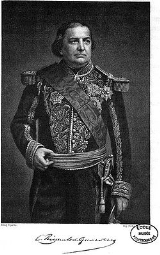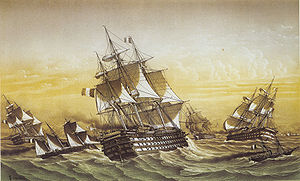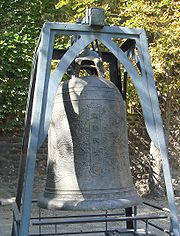
Charles Rigault de Genouilly
Encyclopedia
Pierre-Louis-Charles Rigault de Genouilly (April 12, 1807 in Rochefort, Charente-Maritime
– May 4, 1873 in Barcelona
) was a nineteenth-century French admiral. He fought with distinction in the Crimean War
and the Second Opium War
, but is chiefly remembered today for his command of French and Spanish forces during the opening phase of the Cochinchina campaign
(1858–62), which inaugurated the French conquest of Vietnam
.
Rigault de Genouilly entered the École Polytechnique
in 1825. He entered the navy as a midshipman in 1827, and served in the Morea expedition
aboard the frigate Fleur de Lys during the Greek War of Independence
. In 1828 he was transferred to Résolue, and took part in operations against pirates in the Greek archipelago.
Promoted enseigne de vaisseau in 1830, he participated in the French expedition against Algiers
and the forcing of the Tagus in 1831. In 1832 he served aboard Ducreuse during the blockade of the Dutch coast in the Belgian War of Independence. He was promoted lieutenant de vaisseau in 1834.
In 1843, he assumed command of the corvette Victorieuse on the China and India Seas station, and took part in an expedition to explore the Yellow Sea. On 25 April 1847 Victorieuse and Gloire (capitaine de vaisseau Augustin de Lapierre), which had been sent to Da Nang (Tourane) to negotiate for the release of two French Catholic missionaries, were attacked without warning by several Vietnamese vessels, in an incident known as the Bombardment of Tourane. The two French ships fought back, and with their superior armament rapidly destroyed their attackers. In July 1847 Victorieuse ran aground on the coast of Korea, but Rigault de Genouilly was exonerated from blame by a court of enquiry.
He was promoted captaine de vaisseau in July 1848, and served on a commission charged with studying the defences of Havre. He then became chef de cabinet of the navy minister Joseph Grégoire Cazy. Between 1849 and 1851 he was captain successively of the paddle steamer
frigate Vauban and of Charlemagne, the first screw-driven French battleship converted from a sailing ship. This type of conversion was called a vaisseau mixte to distinguish it from purpose-built steam ships such as Napoléon. He conducted extensive tests on Charlemagne, for which he received the thanks of the admiralty.
 In 1853 he was appointed flag-captain of the ship of the line Ville de Paris
In 1853 he was appointed flag-captain of the ship of the line Ville de Paris
by Admiral Hamelin and took part in the bombardment of Odessa on 22 April 1854, one of the early naval actions of the Crimean War
. Promoted contre-amiral (rear admiral) in 1854, he served with distinction in the siege of Sebastopol, where he was in command of the French marines (fusiliers-marins).
 In 1857 Rigault de Genouilly sailed aboard the frigate Némésis
In 1857 Rigault de Genouilly sailed aboard the frigate Némésis
to join the naval armada assembled by Admiral Léonard Charner for the Second Opium War
, and was placed in command of the French naval division. During the campaign he took part in the blockade of Macau and captured the city of Canton
.
After this success he served at the capture of the Peiho forts and accompanied the Anglo-French expedition to Tientsin.
and captured the city.
The allies expected an easy victory, but the war did not at first go as planned. Vietnamese resistance was more stubborn than had been expected, and the French and Spanish found themselves besieged in Da Nang by a Vietnamese army under the command of Nguyen Tri Phuong. The Siege of Đà Nẵng lasted for nearly three years, and although there was little fighting disease took a heavy toll of the allied expedition. The siege eventually ended with the unopposed evacuation of the French garrison in March 1860.
 Shortly after his capture of Da Nang, Rigault de Genouilly cast around for somewhere else to strike the Vietnamese. In January 1859 he proposed to the navy ministry an expedition against Saigon in Cochinchina, a city of considerable strategic significance as a source of food for the Vietnamese army. The expedition was approved, and in early February, leaving capitaine de vaisseau Thoyon at Da Nang with a small French garrison, Rigault de Genouilly sailed south for Saigon with a powerful naval flotilla and a Franco-Spanish landing force. On 17 February 1859, after forcing the river defences and destroying a series of forts and stockades along the Saigon river, Rigault de Genouilly captured Saigon. The allies were not strong enough to hold the enormous Citadel of Saigon
Shortly after his capture of Da Nang, Rigault de Genouilly cast around for somewhere else to strike the Vietnamese. In January 1859 he proposed to the navy ministry an expedition against Saigon in Cochinchina, a city of considerable strategic significance as a source of food for the Vietnamese army. The expedition was approved, and in early February, leaving capitaine de vaisseau Thoyon at Da Nang with a small French garrison, Rigault de Genouilly sailed south for Saigon with a powerful naval flotilla and a Franco-Spanish landing force. On 17 February 1859, after forcing the river defences and destroying a series of forts and stockades along the Saigon river, Rigault de Genouilly captured Saigon. The allies were not strong enough to hold the enormous Citadel of Saigon
, and on 8 March 1859 blew it up and set fire to its rice magazines. In April Rigault de Genouilly returned to Da Nang with the bulk of his forces to reinforce Thoyon's hard-pressed garrison. On 8 May 1859 he personally led a French attack on the Vietnamese siege lines at Da Nang. The attack achieved limited success, but the French were unable to break the siege.
In October 1859 Rigault de Genouilly, whose actions in Cochinchina had been severely criticised in France, was replaced by Admiral François Page, who was instructed to obtain a treaty protecting the Catholic faith in Vietnam but not to seek any territorial gains.
. He only held the position for a few days, and was replaced by Edmond Le Bœuf on August 21, 1869.
Rigault de Genouilly turned down the offer of command of one of the French fleets during the Franco-Prussian War
and resigned as navy minister on the fall of the Second Empire after the battle of Sedan
. One of his last acts as navy minister was to order naval personnel and gunboats to take part in the Siege of Paris. After his resignation he retired to Spain to live out his last years. He died in Barcelona in 1873.
Rochefort, Charente-Maritime
Rochefort is a commune in southwestern France, a port on the Charente estuary. It is a sub-prefecture of the Charente-Maritime department.-History:...
– May 4, 1873 in Barcelona
Barcelona
Barcelona is the second largest city in Spain after Madrid, and the capital of Catalonia, with a population of 1,621,537 within its administrative limits on a land area of...
) was a nineteenth-century French admiral. He fought with distinction in the Crimean War
Crimean War
The Crimean War was a conflict fought between the Russian Empire and an alliance of the French Empire, the British Empire, the Ottoman Empire, and the Kingdom of Sardinia. The war was part of a long-running contest between the major European powers for influence over territories of the declining...
and the Second Opium War
Second Opium War
The Second Opium War, the Second Anglo-Chinese War, the Second China War, the Arrow War, or the Anglo-French expedition to China, was a war pitting the British Empire and the Second French Empire against the Qing Dynasty of China, lasting from 1856 to 1860...
, but is chiefly remembered today for his command of French and Spanish forces during the opening phase of the Cochinchina campaign
Cochinchina Campaign
The Cochinchina campaign , fought between the French and the Spanish on the one side and the Vietnamese on the other, began as a limited punitive campaign and ended as a French war of conquest...
(1858–62), which inaugurated the French conquest of Vietnam
Vietnam
Vietnam – sometimes spelled Viet Nam , officially the Socialist Republic of Vietnam – is the easternmost country on the Indochina Peninsula in Southeast Asia. It is bordered by China to the north, Laos to the northwest, Cambodia to the southwest, and the South China Sea –...
.
Early career
Charles Rigault de Genouilly was born and raised in Rochefort into a family with naval connections. His father was a naval engineer and his mother, Adélaïde-Caroline Mithon de Genouilly, was the niece and adopted daughter of Claude Mithon de Genouilly, a naval commander during the American War of Independence.Rigault de Genouilly entered the École Polytechnique
École Polytechnique
The École Polytechnique is a state-run institution of higher education and research in Palaiseau, Essonne, France, near Paris. Polytechnique is renowned for its four year undergraduate/graduate Master's program...
in 1825. He entered the navy as a midshipman in 1827, and served in the Morea expedition
Morea expedition
The Morea expedition is the name given in France to the land intervention of the French Army in the Peloponnese, between 1828 and 1833, at the time of the Greek War of Independence....
aboard the frigate Fleur de Lys during the Greek War of Independence
Greek War of Independence
The Greek War of Independence, also known as the Greek Revolution was a successful war of independence waged by the Greek revolutionaries between...
. In 1828 he was transferred to Résolue, and took part in operations against pirates in the Greek archipelago.
Promoted enseigne de vaisseau in 1830, he participated in the French expedition against Algiers
Algiers
' is the capital and largest city of Algeria. According to the 1998 census, the population of the city proper was 1,519,570 and that of the urban agglomeration was 2,135,630. In 2009, the population was about 3,500,000...
and the forcing of the Tagus in 1831. In 1832 he served aboard Ducreuse during the blockade of the Dutch coast in the Belgian War of Independence. He was promoted lieutenant de vaisseau in 1834.
In 1843, he assumed command of the corvette Victorieuse on the China and India Seas station, and took part in an expedition to explore the Yellow Sea. On 25 April 1847 Victorieuse and Gloire (capitaine de vaisseau Augustin de Lapierre), which had been sent to Da Nang (Tourane) to negotiate for the release of two French Catholic missionaries, were attacked without warning by several Vietnamese vessels, in an incident known as the Bombardment of Tourane. The two French ships fought back, and with their superior armament rapidly destroyed their attackers. In July 1847 Victorieuse ran aground on the coast of Korea, but Rigault de Genouilly was exonerated from blame by a court of enquiry.
He was promoted captaine de vaisseau in July 1848, and served on a commission charged with studying the defences of Havre. He then became chef de cabinet of the navy minister Joseph Grégoire Cazy. Between 1849 and 1851 he was captain successively of the paddle steamer
Paddle steamer
A paddle steamer is a steamship or riverboat, powered by a steam engine, using paddle wheels to propel it through the water. In antiquity, Paddle wheelers followed the development of poles, oars and sails, where the first uses were wheelers driven by animals or humans...
frigate Vauban and of Charlemagne, the first screw-driven French battleship converted from a sailing ship. This type of conversion was called a vaisseau mixte to distinguish it from purpose-built steam ships such as Napoléon. He conducted extensive tests on Charlemagne, for which he received the thanks of the admiralty.
Crimean War

French ship Ville de Paris (1851)
The Ville de Paris was an Océan class 118-gun ship of the line of the French Navy.Her keeled was in Rochefort in 1807 as Marengo. During her construction, she was renamed Ville de Vienne, Comte d'Artois during the Bourbon Restoration, Ville de Vienne again briefly during the Hundred Days and back...
by Admiral Hamelin and took part in the bombardment of Odessa on 22 April 1854, one of the early naval actions of the Crimean War
Crimean War
The Crimean War was a conflict fought between the Russian Empire and an alliance of the French Empire, the British Empire, the Ottoman Empire, and the Kingdom of Sardinia. The war was part of a long-running contest between the major European powers for influence over territories of the declining...
. Promoted contre-amiral (rear admiral) in 1854, he served with distinction in the siege of Sebastopol, where he was in command of the French marines (fusiliers-marins).
Second Opium War

French frigate Némésis (1847)
The French frigate Némésis was an Artémise class screw-powered 50-gun second rate frigate of the French Navy in the 19th century. She was launched in 1847 at Brest, and participated in campaigns in Asia....
to join the naval armada assembled by Admiral Léonard Charner for the Second Opium War
Second Opium War
The Second Opium War, the Second Anglo-Chinese War, the Second China War, the Arrow War, or the Anglo-French expedition to China, was a war pitting the British Empire and the Second French Empire against the Qing Dynasty of China, lasting from 1856 to 1860...
, and was placed in command of the French naval division. During the campaign he took part in the blockade of Macau and captured the city of Canton
Guangzhou
Guangzhou , known historically as Canton or Kwangchow, is the capital and largest city of the Guangdong province in the People's Republic of China. Located in southern China on the Pearl River, about north-northwest of Hong Kong, Guangzhou is a key national transportation hub and trading port...
.
After this success he served at the capture of the Peiho forts and accompanied the Anglo-French expedition to Tientsin.
War in Vietnam
In November 1857, in response to the execution of two Spanish missionaries by the Vietnamese emperor Tự Đức and the failure of a diplomatic mission to Huế led by Charles de Montigny, Rigault de Genouilly was authorised by the French emperor Napoleon III to launch a punitive expedition against Vietnam. In September 1858 a joint French and Spanish expedition under his command landed at Da NangDa Nang
Đà Nẵng , occasionally Danang, is a major port city in the South Central Coast of Vietnam, on the coast of the South China Sea at the mouth of the Han River. It is the commercial and educational center of Central Vietnam; its well-sheltered, easily accessible port and its location on the path of...
and captured the city.
The allies expected an easy victory, but the war did not at first go as planned. Vietnamese resistance was more stubborn than had been expected, and the French and Spanish found themselves besieged in Da Nang by a Vietnamese army under the command of Nguyen Tri Phuong. The Siege of Đà Nẵng lasted for nearly three years, and although there was little fighting disease took a heavy toll of the allied expedition. The siege eventually ended with the unopposed evacuation of the French garrison in March 1860.

Citadel of Saigon
The Citadel of Saigon also known as the Citadel of Gia Dinh was a square Vauban stone fortress that stood in Saigon , Vietnam from its construction in 1790 until its destruction in February 1859...
, and on 8 March 1859 blew it up and set fire to its rice magazines. In April Rigault de Genouilly returned to Da Nang with the bulk of his forces to reinforce Thoyon's hard-pressed garrison. On 8 May 1859 he personally led a French attack on the Vietnamese siege lines at Da Nang. The attack achieved limited success, but the French were unable to break the siege.
In October 1859 Rigault de Genouilly, whose actions in Cochinchina had been severely criticised in France, was replaced by Admiral François Page, who was instructed to obtain a treaty protecting the Catholic faith in Vietnam but not to seek any territorial gains.
Later career
Between 1862 and 1864, following his return to France, Rigault de Genouilly served first aboard Bretagne and then aboard Ville de Paris as commander of the French squadron of evolutions (escadre d’évolutions) in the Mediterranean. He was navy minister from 20 January 1867 to 4 September 1870, replacing Justin de Chasseloup-Laubat. He also became Minister of War on August 13, 1869, succeeding Adolphe NielAdolphe Niel
Adolphe Niel was a French Army general and statesman, also Marshal of France.He was born at Muret, Haute-Garonne and entered the École Polytechnique in 1821. Niel entered the engineer school at Metz, became lieutenant in the Engineers Corps in 1827, and captain in 1833...
. He only held the position for a few days, and was replaced by Edmond Le Bœuf on August 21, 1869.
Rigault de Genouilly turned down the offer of command of one of the French fleets during the Franco-Prussian War
Franco-Prussian War
The Franco-Prussian War or Franco-German War, often referred to in France as the 1870 War was a conflict between the Second French Empire and the Kingdom of Prussia. Prussia was aided by the North German Confederation, of which it was a member, and the South German states of Baden, Württemberg and...
and resigned as navy minister on the fall of the Second Empire after the battle of Sedan
Battle of Sedan
The Battle of Sedan was fought during the Franco-Prussian War on 1 September 1870. It resulted in the capture of Emperor Napoleon III and large numbers of his troops and for all intents and purposes decided the war in favour of Prussia and its allies, though fighting continued under a new French...
. One of his last acts as navy minister was to order naval personnel and gunboats to take part in the Siege of Paris. After his resignation he retired to Spain to live out his last years. He died in Barcelona in 1873.

